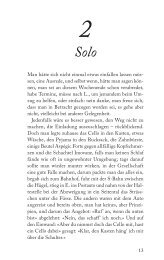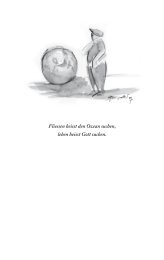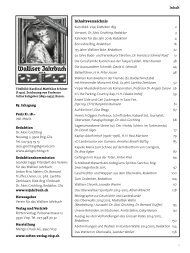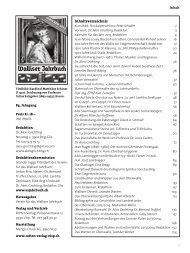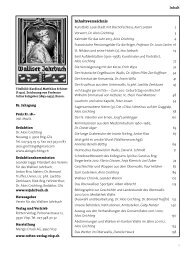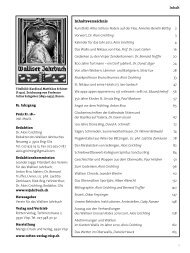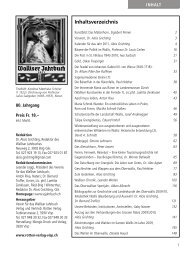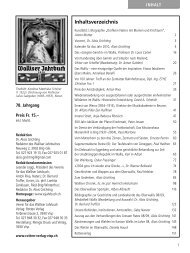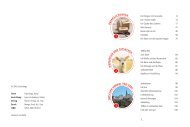Biner_Leseprobe
Create successful ePaper yourself
Turn your PDF publications into a flip-book with our unique Google optimized e-Paper software.
On August 13 of 1792, natural scientist Horace-Bénédict de Saussure<br />
climbed the Klein Matterhorn (3,883m) for scientific purposes, together<br />
with mountain guide Joseph-Marie Couttet from Chamonix and 6 other<br />
guides. He measured the height of the Matterhorn with surprising accuracy:<br />
4,501m – exceeding today’s official measurement only by 23m.<br />
De Saussure explored the Alps in their entirety. He recorded barometric<br />
measurements, humidity and the intensity of the blue sky. In 1787, he undertook<br />
the first scientific ascent of the Mont Blanc, only one year after<br />
its first ascent. On the Italian side of the Monte Rosa, there were also<br />
scientists going about their investigations, among them topographer Joseph<br />
Zumstein and physician Friedrich Parrot.<br />
Back in those days, the clergy house was the only accommodation available<br />
in Zermatt. As of 1812, the pastor kept a visitors’ log. He recorded<br />
about 10 people a year. It was only after the Britons began exploring the<br />
Alps that the athletic aspect was added to alpinism, namely in the 1830s.<br />
Apparently, mountain guides started professionalising in Zermatt around<br />
1830, as well. In 1832, a certain Johann <strong>Biner</strong> called himself “the first<br />
botanical mountain guide of Zermatt”, whatever that meant. Peter Taugwalder<br />
Senior, who in 1865 (at the age of 45) belonged to the group of<br />
mountaineers who first ascended the Matterhorn, took up his profession in<br />
1840. By 1865, he had already climbed the Monte Rosa about 90 times.<br />
In 1838, ‘barber surgeon’ Joseph Lauber let three beds in his private<br />
house and quickly named the house Hotel Cervi. His hotel sign carried<br />
the inscription “Hotel Mont Cervi, bon loge à cheval et à pied” (French for<br />
‘good lodging for riders and pedestrians’). In 1852, Joseph Anton Clemenz<br />
of Visp, a member of the cantonal government, founded the first ‘real’<br />
Hotel in Zermatt, the precursor of the Hotel Mont Cervin. In its first year,<br />
the hotel registered 12 guest-nights. Lauber was not able to keep up with<br />
this kind of competition, so he sold his house to Alexander Seiler in 1854,<br />
who then changed its name to Hotel Monte Rosa. He refurbished and expanded<br />
the house, which then counted 28 beds. In 1867, Alexander Seiler<br />
also bought the Hotel Mont Cervin. In the early days of alpinism, the Seiler<br />
family contributed significantly to the boost in tourism in Zermatt.<br />
The conquest of the Zermatt Mountains<br />
11







